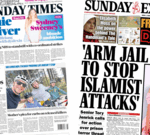Glenn Campbell
Political Editor, BBC Scotland
SNS
Hamilton Park Racecourse sits just beyond the boundary of the latest by-election battlefield
The famous Hamilton Park Racecourse lies on the edge of town, just beyond the boundary of the Holyrood constituency where voters are set to elect a new MSP.
Its presence is a useful reminder that few places in Scotland are as familiar with runners and riders, favourites and outsiders.
The current political race in this former coal mining heartland of west central Scotland will decide who represents Hamilton, Larkhall and Stonehouse in the Scottish Parliament following the death of the SNP’s Christina McKelvie.
It also has wider significance.
It is the largest test of voter opinion in Scotland since the UK general election in which Labour heavily defeated the SNP.
It is also the first real opportunity to see if Reform UK’s recent successes in England can give them what they call a “tartan bounce”.
The outcome will help shape the political narrative in Scotland ahead of the national Holyrood election next May.
While Hamilton has its place in the history of horse racing, it has also earned iconic status when it comes to jockeying for political power.
It was here that Winnie Ewing made her stunning by-election breakthrough for the SNP in 1967.
It was this town that gave the former NATO secretary general Lord Robertson his start at Westminster in 1978.
It was the people of Hamilton South who elected Labour’s Tom McCabe as the first MSP in 1999.
Driving around what is now the Hamilton, Larkhall and Stonehouse constituency, you would be forgiven for thinking the 2025 contest was a two horse race between the SNP and Reform UK.
That’s only because these are the parties dominating billboard advertising.
This observation takes no account of the intensive door knocking, direct mailing and social media campaigning that’s been going on for weeks.
PA Media
SNP leader John Swinney has been a familiar face around the constituency in the lead up to polling day
The SNP leader John Swinney has certainly acknowledged a third, red rosette-wearing horse in this race.
My sense is that his comment came as something of a relief to Scottish Labour, who came second last time and expect to be regarded as the principal challenger to the SNP, who are defending the seat.
Labour could certainly do with a win here.
Having swept to power at Westminster last summer, Sir Keir Starmer’s party quickly lost popularity with decisions like cutting winter fuel payments for pensioners.
Even though changes to that policy have been promised, they will come too late for this by-election. The damage to Scottish Labour seems to have been done.
The SNP tends to have a double digit lead over Labour in national opinion polls, with support for pro-UK parties heavily fragmented since the rise of Reform.
That means that with around a third of the vote, the SNP can still be winners because Reform UK is principally drawing support away from the Conservatives and Labour.
The arithmetic already takes into account a series of SNP controversies over independence strategy, gender self-identification, a poli
Read More




